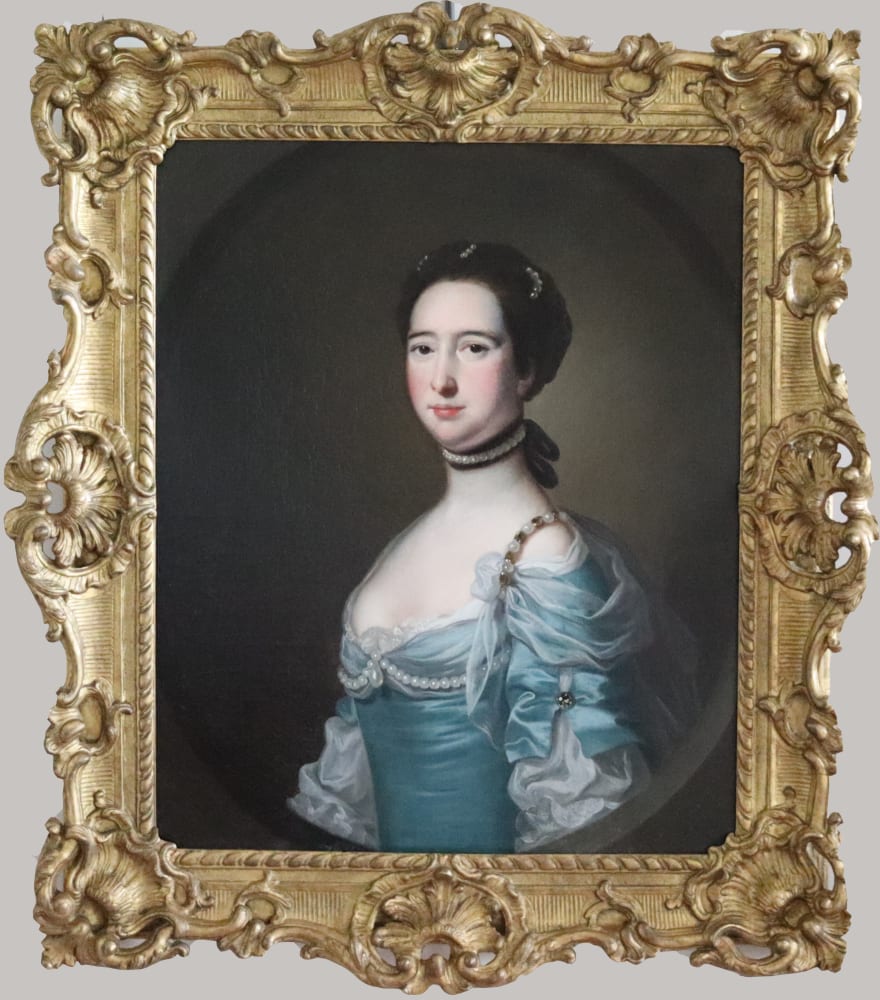Circle of Joseph Wright of Derby (1734-1797)
Literature
Neil Jeffares, 'Dictionary of pastellists before 1800, Astley, Mrs Edward',
Martin Postle 'Doddington and the Delavals; collecting and display in the 1760s', Art and the Country House, November 2020.
Portrait of a lady, circa 1755, half-length, wearing a pearl and black silk choker and a blue silk gown with white undersleeves, adorned with gauze trim and pearls, her dark hair dressed with strings of pearls. The sitter is believed to be the artist Mrs Edward Astley, born Rhoda Delaval (London c.1725-1757 Bath)
Oil on canvas in an English 18th century gilded frame.
Rhoda Delaval was the daughter of a naval captain who had inherited the Vanburgh mansion Seaton Delaval from an uncle. Rhoda Delaval was celebrated for her beauty and accomplishments, among them her skill as a portrait artist. In 1744 she began taking lessons from the artist Arthur Pond, who was already popular in court circles. Pond was commissioned by her parents to paint numerous family portraits (among them one of Rhoda and three of her brothers) and it is thought that one of her younger brothers, George Delaval was appreticed to Pond for five years.
In 1751 she married Edward Astley of Melton Constable, Norfolk (he was later made a baronet). The couple divided their time between Seaton Delaval and their London residence at no. 10-11 Downing Street in London. A painting attributed to Pond of Rhoda , currently on loan from the NPG to the museum at no.1 Royal Crescent in Bath, shows her executing a pastel portrait. She was also painted in Turkish costume by George Knapton (Seaton Delaval) and Sir Joshua Reynolds (private collection, Ireland) in 1756, shortly before her death, said to be as the result of the loss of two of her eldest children. Her surviving son, Sir Jacob Henry Astley eventually inherited the family estates.
An early work of Joseph Wright of Derby, or working in the circle of is suggested as a possible attribution for this portrait. Wright (1734-1797) was an English painter, active mainly in his native town and generally known as ‘Wright of Derby’. He was one of the most original, versatile, and accomplished British artists of the 18th century and the first major English painter whose career was based outside London. In 1751–3 and again in 1756–7 he trained under Thomas Hudson in London, and this work shows a strong influence of Hudson's portrait style.
After returning to Derby he made a name as a portraitist in the Midlands, his works displaying fluent composition and a firm grasp of character. In the 1760s he began to paint candlelit scenes of various types, showing the fascination with unusual lighting effects that was to run throughout his career. He was influenced in some of these by Dutch painting, but in his depictions of the contemporary scientific world he broke new ground—his most famous work, An Experiment on a Bird in the Air Pump (1768, NG, London), has been described by Sir Ellis Waterhouse as ‘one of the wholly original masterpieces of British art’. Such works won him a considerable reputation, and in 1772 James Northcote called him ‘the most famous painter now living for candle-lights’. In 1768–71 Wright worked in Liverpool, and in 1773–5 (in company with John Downman) he visited Italy, where he assiduously studied the antique but was even more impressed by the eruption of Vesuvius that he witnessed whilst there and the great fireworks display held annually at the Castel S. Angelo in Rome (he painted several pictures of both subjects). On his return to England in 1775 he moved to Bath, hoping to fill the gap left by Gainsborough's departure for London, but his more forthright style did not please sophisticated society there and in 1777 he returned to Derby. He remained there for the rest of his life apart from short journeys when he made tours of the Lake District in 1793 and 1794 to study landscapes which became an increasingly important part of his work towards the end of his career.






